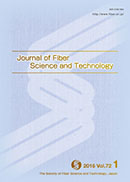
- |<
- <
- 1
- >
- >|
-
Masahiro Fukuhara, Natsuho Sato, Yoshimasa Amano, Motoi MachidaArticle type: Note
2025Volume 81Issue 4 Pages 51-57
Published: March 31, 2025
Released on J-STAGE: April 12, 2025
JOURNAL FREE ACCESSPyridinic nitrogen (N-6) in flame resistant polyacrylonitrile (PAN) fiber was converted to positively charged quaternary nitrogen (N-Q) of methyl pyridine using methyl iodide at 40°C to prepare carbon fiber adsorbents to remove a negatively charged pollutant of nitrate from aqueous solution. The prepared PAN fiber adsorbent could uptake nitrate above 0.3 mmol/g from 3 mmol/L nitrate solution, whereas only 0.03 mmol/g of nitrate was captured with the unmodified PAN fiber. Some reaction conditions for methylation were examined to maximize nitrate and above 0.6 mmol/g of nitrate adsorption could be achieved at equilibrium solution pH (pHe) 3. Langmuir adsorption isotherm could be applied to the nitrate adsorption at solution pHe 3 and calculated adsorption affinity (Ke) and capacity (Xm) of nitrate were 0.24 L/mmol and 2.39 mmol/g, respectively, for the optimum prepared conditions for the adsorbent. Influence of pHe on nitrate adsorption was also inspected for the modified PAN adsorbent and above 0.3 mmol/g at pHe 1-3 was maintained and above 0.15 mmol/g in a constant value at pHe 6-10 under standard conditions indicating that 0.15 mmol/g or greater number of quaternary nitrogen (N-Q) might be exposed to the PAN surface. XPS N1s analysis and Boehm titration support the presence of N-Q species on the modified PAN sample to adsorb nitrate.
View full abstractDownload PDF (1099K)
-
Hironori Izawa, Nanaka Baba, Miho Araki, Shinsuke IfukuArticle type: Transaction
2025Volume 81Issue 4 Pages 58-63
Published: March 31, 2025
Released on J-STAGE: April 12, 2025
JOURNAL FREE ACCESSε-Poly-L-lysine (PL) is a natural polymer bearing a key amino group that provides it with a cationic nature, high reactivity in water, and consequent broad applicability. Here we prepared a guanidinylated PL (GPL) exhibiting an enhanced cationic nature by guanidinylation of the amino group with 1-amidinopyrazole hydrochloride (AP) and trimethylamine (TEA) (AP-TEA system). In the AP-TEA system using 3 eq of AP for 2 days at room temperature, a GPL with the degree of guanidinylation (DG) of 100% was achieved. The DG value could be controlled by the AP amount. The lower acidity of the GPL relative to PL was confirmed by pH titration; the reduced acidity resulted in enhanced antibacterial activity of the GPL under an alkaline condition (pH 8.0 and 9.0).
View full abstractDownload PDF (1453K)
- |<
- <
- 1
- >
- >|